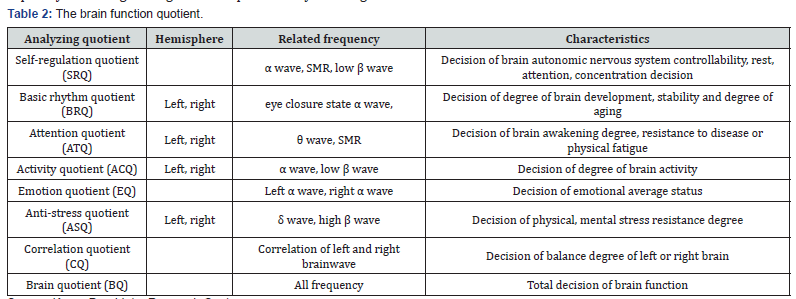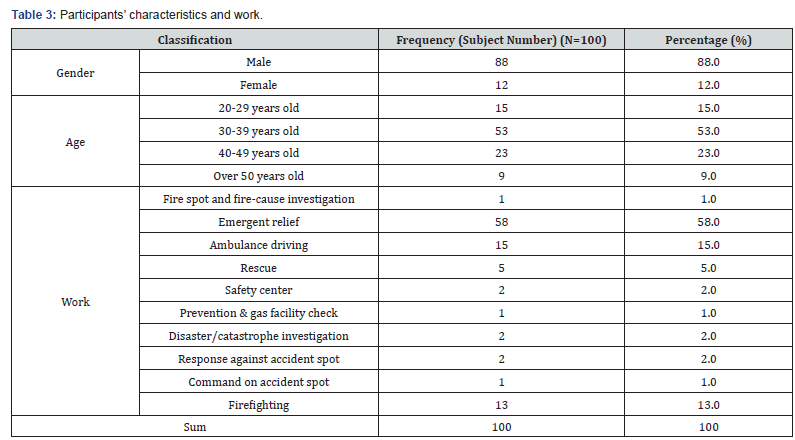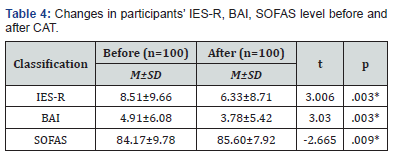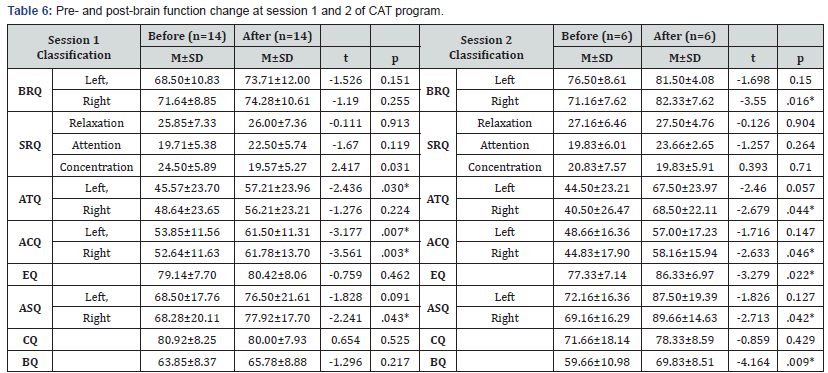Effects of Short-Term Clinical Art Therapy in Firefighters with Post-Traumatic Stress Risk- Juniper Publishers
Juniper publishers- Journal of complementary medicine
Abstract
The purpose of this study is to identify event shock,
anxiety, occupational and social functioning, and electroencephalogram
(EEG) changes by conducting clinical art therapy (CAT) immediately after
participants experience traumatic events. This study involved 100
firefighters from Seoul Metropolitan Fire and Disaster Headquarters in
South Korea. During field activities, firefighters who experienced or
witnessed two or more deaths, child death, the death of fellow
firefighters, life-threatening accidents, suicide incidents, or assault
were targeted.
From June 1 to December 31, 2015, researchers
visited the fire stations to conduct a group survey and CAT sessions.
Each CAT session lasted 60 minutes, and two sessions were provided. As
for the test tools, a questionnaire regarding the traumatic event, along
with EEG, impact of event scale-revised (IES-R), Beck Anxiety Inventory
(BAI), social and occupational functioning assessment scale (SOFAS)
were used. Before/after tests were conducted before the beginning of the
first session and after the end of the second session.
After the firefighters engaged in CAT sessions, the
level of IES-R (t=3.006, p=.003) and BAI (t=3.030, p=.003) decreased
while SOFAS (t=-2.665, p=.009) increased. In addition, there was a
positive change in the brain function index, showing a statistically
significant change in six items.
This study shows that CAT can help reduce the impact
of traumatic events. We hope that the findings and suggestions
contained in this paper can contribute to reducing the psychological and
psychological trauma of firefighters.
Keywords: PTSD; IES-R; Anxiety; Complementary and integrative medicine; EEG
Abbrevations: EEG:
Electroencephalogram; CAT: Clinical Art Therapy; IES-R: Impact of Event
Scale-Revised; BAI: Beck Anxiety Inventory; SOFAS: Social and
Occupational Functioning Assessment Scale; BRQ: Basic rhythm quotient;
SRQ: Self-regulation quotient; ATQ: Attention quotient; ACQ: Activity
quotient; EQ: Emotion quotient; ASQ: Anti-stress quotient; CQ:
Correlation quotient; BQ: Brain quotient
Introduction
Trauma first refers to a physical injury or shock
caused by violence or aggressive behavior, and second; to an experience
that causes psychological damage or pain [1]. Professional rescue
workers (e.g., police and firefighters) commonly serve as responders to
disasters or emergencies, and they are routinely exposed to traumatic
events during the course of their duties [2]. Firefighters are not only
responsible for preventing and fighting fires but are also charged with
various other important tasks, such as rescuing victims and providing
emergency medical aid. Often, firefighters are the first to arrive at
the scene of violent or tragic events; therefore, they frequently have
to handle victims’ gruesome injuries or witness victims’ death or even
the deaths of their colleagues. For this reason, firefighters suffer
from injuries or threats, and experience trauma either directly or
indirectly [3,4].
The prevalence rates of PTSD symptoms for US and
Canadian city firefighters measured using IES were 22.2% and 17.3%,
respectively [5]. The rate of high-risk PTSD was 17.7% for firefighters
working in the fire department of a Japanese city and was estimated
using IES-R [6].
Firefighters have higher levels of anxiety and
depression compared to other groups and are exposed to various mental
illnesses [7]. The more traumatic events one experiences, the more
likely they are to experience severe symptoms of post-traumatic stress
(PTS) [8]. Firefighters require counseling and treatment programs
because they are classified as a high-risk group in regard to PTS
accompanied by fear, helplessness, and suffering caused by repeated
exposure to trauma [9].
Since the issues of disaster, stress, and PTS are
drawing more attention from the public, various prevention and treatment
techniques have been suggested. Among the approximately 200
complementary therapies that currently exist, clinical art therapy (CAT)
is an effective therapy for comprehensively assessing and improving
physical, mental, psychological, social, and spiritual
health. CAT is studied in the field of complementary and alternative
medicine (CAM) and has already been applied in clinical practice
as part of orthodox medicine [10].
CAT is a form of therapy that combines with art and medicine,
evaluating (diagnosing) a patient’s physical and mental condition
through art activities; and improving treatment and mitigating
symptoms of a disease [11]. CAT allows nonverbal communication
in the treatment and mitigation of symptoms, thus aiding in
mental outbursts that cannot be expressed in words. It facilitates
the safe release of anxiety and other issues [12]. In many cases,
psychological trauma is accompanied by clear traumatic images
which remain edged in the memory for an extended time. Due to the
trauma or mental shock experienced during an accident, patients
become anxious when they face similar situations. Psychological
trauma sometimes shuts down language processing, and the event
is remembered as a nonverbal image and is reproduced visually
[13].
CAT provides patients experiencing trauma with an
opportunity to express their natural human desires, such as
crisis, sorrow, and despair; and offers psychological support for
patients to explore and overcome their trauma. It also attempts
to help patients meaningfully explore the emotions and ideas
related to acute or chronic trauma in order to facilitate their
mental, emotional, and physical management [14]. As a result of
these therapeutic effects, CAT, as a field of CAM, is effective for
psychotherapy.
The final goal of therapeutic work in PTS is for patients to
regain their level of functioning before the trauma occurred
[15,16]. However, this does not mean that the patient returns to
his/her previous state of trauma; but rather, that the patient is
able to accept the traumatic event and adapt to his/her daily life
by integrating their experience into it [17].
Therefore, it is necessary to introduce immediate therapeutic
interventions after exposure to trauma, as well as interventions
for the management of stress after a crisis event. It is necessary
to develop a prevention and treatment program that is capable of
achieving psychological stability among firefighters, reducing the
level of event shock, and positively affecting their physical health
and social relationships. Further, there should be an opportunity
to apply such programs in a systematic manner.
The purpose of this study is to identify event shock, anxiety,
occupational and social functioning, and electroencephalogram
(EEG) changes by conducting CAT immediately after patients
experience traumatic events. In addition, we attempted to break
out of the method limited to the conventional questionnaire and
presented the results of EEG changes to verify the effectiveness
of CAM.
Materials and Methods
Participants and procedures
The purpose of the program was to reduce the intensity of
PTS that occurred during field activities, and to prevent mental
problems. This study involved 100 firefighters from Seoul
Metropolitan Fire and Disaster Headquarters in South Korea.
Written informed consent was obtained from the participants
before the study. The participants of the study were firefighters
engaged in field activities. During field activities, firefighters who
experienced two or more deaths, child deaths, deaths of fellow
firefighters, life-threatening accidents, suicide incidents, or assault
were targeted.

Table Abbreviations: CAT: Clinical art therapy.
From June 1 to December 31, 2015, researchers visited the fire
stations to conduct a group survey and CAT sessions. The research
was conducted at six fire stations and eight safety centers in Seoul.
In this study, two clinical art therapy specialists, five clinical art
therapists, and supervisors (professor of clinical art therapy/
professor of biomedical science) participated. One clinical art
therapy specialist and two clinical art therapists visited each fire
station. We conducted a pre- and post-test and the CAT, and two
supervisors reviewed and advised on the pre- and post-test and
program.
Two CAT sessions, each lasting 60 minutes, were provided.
Before/after tests were conducted before the beginning of the first
session and after the end of the second session.
Intervention
Both the first session and the second session were conducted
for 60 minutes except for the pre- and post-test. The program
structure and materials are shown in Table 1. The presented
materials were freely chosen and used.
The masterpieces presented 300 paintings by 30 artists from
the 19th century to the present. In order to prevent the bias of
the researchers in selecting the works of each artist, we used
works that were officially published in the artists’ work books.
In addition, a description of each painter and a description of the
work are also presented.
After presenting various masterpieces on the desk, one clinical
art therapy specialist explained the program. ‘These paintings are
the works of painters, and they express their emotions. There may
be a painter we know and some we do not know. Please select any
two to three works from the various works. You can choose works
that you empathize with or choose your favorite works. Then,
reconstruct the selected works and freely express them on the
drawing paper. In addition to the selected works, you may select
other works. After completing the work, we will set a title for each
picture, and take a moment to discuss the criterion used to select
the painting and the work that each person expressed.’
Instructions for the program of the second session are as
follows.
‘Knead enough clay. When you have kneaded enough clay,
express your feelings, thoughts, and experiences by touching the
clay freely. The work can be made in sculpture. Using water to
knead the clay may feel different. ‘
Two clinical art therapists, acting as assistant therapists,
explained to the subjects how to use the materials and helped
the subjects who had difficulty expressing their works. Pre- and
post-test results, the works’ photographs, and consultations were
recorded after the program was completed.
Study tools
Impact of event scale-revised: IES-R: The IES was developed
by Horowitz for the purpose of studying the shock and adjustment
process after a traumatic event, and it has been widely used in
traumatic-experience studies [6]. In this study, the researchers
employed a modified version of the IES-R scale, where Eun scaled
down the original five-point scale [18]. The Korean version of the
IES-R was standardized with good internal consistency (α = .93)
[19]
Beck anxiety inventory: BAI: The BAI is a scale that was
developed by Beck, Epstein, Brown and Steer [20]. This self-report
test was designed to measure the level of anxiety among patient
and non-patient groups, and it contains 21 questions. It evaluates
mental and physical symptoms to identify the intensity of anxiety.
Social and occupational functioning assessment scale:
SOFAS: The SOFAS was developed to measure social and job
functioning [21]. The score is given in the minimum unit of ten
points. Each step has been defined and its criterion has been
described. This tool is focused only on functioning levels and
does not include any measurement of symptoms. A higher score
indicates high social functioning on the subject.

Source: Korea Psychiatry Research Center
Electroencephalogram: EEG: EEG was measured using
the Neurofeedback System (Braintech Corp, Korea) developed
in the Korea Psychiatry Research Center. Neuro Harmony, a
neurofeedback system, was implemented on the basis of twochannel
brainwave measurements, which were performed in
the frontal lobe using a bi-polar inductive method. This study
measured and analyzed the change in brain waves from session
1 and session 2 pre- and post-CAT. The type and characteristics of
the EEG are shown in Table 2.
The EEG in this study was performed on 14
firefighters who, at
25 points or more which is the cut-off point of the Korean version of
the IES-R scale, were at risk of PTSD. PTSD diagnostic cut-off
point was used in the reliability and validity study of the Korean
version of the IES-R comparing the PTSD group and the normal
group, with a sensitivity of 1.0 and the highest specificity score of
24/25 [18]. The classification of the PTSD risk group was based on
the Korean version of the IES-R score of 24/25 as the diagnostic
cut point of PTSD.
CAT program
CAT was conducted in two programs.
The first program involves the reconstruction of masterpieces.
As one of the various techniques of CAT, art therapy that uses
masterpieces can lead to emotional relaxation and can reduce the
burden of art activities. Through the appreciation of masterpieces,
the participant may understand the psychological state and mental
world of the piece’s painter and simultaneously has an opportunity
for self-reflection, thereby finding clues to healing. This technique
allows anyone, not only trauma patients, to evaluate their current
thinking and psychological state and experience healing [22].
CAT that uses masterpieces is performed in a way that imitates
and transforms the masterpiece along with the appreciation of
masterpieces. There is an aesthetic element that is experienced
externally, but there is also an internal, logical, cognitive, and
historical experience. Thus, the subject can understand their
feelings and construct new meaning.
The second program involved free expression using clay work.
Clay is one of the most familiar types of art media. Clay can be
used for a variety of expressions and can allow one to creatively
emanate their oppressed feelings. In this process, a psychological
sense of liberation and satisfaction can be felt [21]. In addition, the
soft touch of the clay can engender psychological relaxation [23].
The details of the program used in this study are shown in Table 1.
Analysis
To judge the effectiveness of CAT; IES-R, BAI, SOFAS, and
EEG administered through pre- and post-tests were statistically
analyzed using a paired t-test. We also analyzed correlation with
BAI and SOFAS by the degree of IES-R. The data collected in this
study were statistically analyzed using SPSS 20.0.
Results
Participants
The participant group (N = 100) was composed of 88% males
and 12% females whose ages ranged from 28 to 61 years (Table
3). In terms of age distribution, the largest age group was 30-
39 years, accounting for 53% of the participant group, followed
by the 40-49 years group accounting for 23% of the participant
group. Therefore, 76% of the study participants were in their 30s
or 40s. They experienced an average of 4.76 (SD=3.13) traumatic
events, which means, on average, that they experienced four to
five traumatic events.

The largest sub-group was paramedics (58%), who are
frequently exposed to traumatic events due to the nature of their
work. Particularly among paramedics, failing in CPR was recalled
as a traumatic event, as they maintained a vivid memory of the
event and experienced wild thoughts beyond their control. This
indicates that paramedics experienced more traumatic events and
showed more PTSD symptoms [24].
Influence of CAT on IES-R, BAI, and SOFAS
As shown in Table 4, after firefighters engaged in CAT, the
level of IES-R (t=3.006, p=.003) and BAI (t=3.030, p=.003)
decreased and SOFAS (t=-2.665, p=.009) increased. Such a change
is considered to be statistically significant. Therefore, it can be
concluded that CAT positively contributed to lowering the IES-R
and BAI, enhancing SOFAS among the firefighters.

*p<.05.
Table Abbreviations: CAT: Clinical art therapy; IES-R: Impact of
event scale-revised; BAI: Beck anxiety inventory; SOFAS: Social and
occupational functioning assessment scale.
To examine the relationship between the intensity of the
IES-R and the level of BAI and SOFAS, correlational analyses were
conducted. The results showed that the intensity of the IES-R has
a positive relationship with BAI (r=.473, p=.000), indicating that
as the intensity of the IES-R increased, the level of BAI increased.
However, SOFAS (r=-.147, p=.146) did not show a statistically
significant correlation (Table 5). Firefighters expressed anxiety
but scored highly on SOFAS. This suggests that they believe that
the shock from the events that they chronically face does not affect
their job functioning. As for the job itself, the study participants
took pride in what they do and had a sense of responsibility.
Therefore, they did not think that such experiences negatively
affected their social and occupational functioning.

**p<.001
Table Abbreviations: IES-R: Impact of event scale-revised; BAI:
Beck anxiety inventory; SOFAS: Social and occupational functioning
assessment scale.
Influence of CAT on the change of EEG
Fourteen firefighters with high IES-R scores were selected and
EEG measurements were taken. Because this study was a single
group study without a control group, EEG measurements were
taken four times before and after the program. In the first session,
all fourteen subjects completed the test. In the second session,
eight subjects who did not complete the post-test were excluded
and six subjects completed the test. According to the analysis of
the change in EEG before and after sessions 1 and 2 of CAT, the
score increased for most EEG indices (Table 6).

*p<.05
Table Abbreviations: CAT: Clinical art therapy; BRQ: Basic rhythm
quotient; SRQ: Self-regulation quotient; ATQ: Attention quotient; ACQ:
Activity quotient; EQ:
Emotion quotient; ASQ: Anti-stress quotient; CQ: Correlation quotient;
BQ: Brain quotient
After the session, there was a statistically significant change in
the left brain (t=-2.436, p=.030) for the attention quotient (ATQ),
the left (t=-3.177, p=.007) and right (t=-3.561, p=.003) brain for
the activity quotient (ACQ), and the right brain (t=-2.241, p=.043)
for the anti-stress quotient (ASQ). additionally, after the second
CAT session, there was a statistically significant change in the right
brain (t=-3.550, p=.016) for the basic rhythm quotient (BRQ), the
right brain (t=-2.679, p=.044) for the attention quotient (ATQ) and
the emotion quotient (EQ) (t=-3.279, p=.022), and the right brain
(t=-2.713, p=.042) for the ASQ and the brain quotient (BQ) (t=-
4.164, p=.009).
Discussion
This study aimed to identify IES-R, BAI, and SOFAS and
EEG changes by conducting CAT after participants experienced
traumatic events.
CAT caused a positive change in emotional behavior. Scores on
the IES-R showed a statistically significant decrease after CAT. In
addition, statistically significant changes were found for the BAI
and SOFAS. This means that secondary issues that may arise from
the impact of a traumatic event can be prevented through CAT.
The degree of IES-R negatively affected BAI. This means that
anxiety increases with increase in traumatic incidents. However,
there was no significant correlation between the IES-R and SOFAS.
This is because most study participants experienced continuous
trauma that often became chronic, and they did not think that
they would leave their job because of their symptoms. Most of the
participants reported seemingly better conditions than the reality.
Analysis of the EEG showed statistically significant changes in
the left and right brain for the ATQ, the left and right brain for the
ACQ, the right brain for the ASQ, and the right brain for the BRQ,
EQ, and BQ. Most of the items in the eight EEG indices showed a
positive change after CAT, with a statistically significant change for
six items.
After the first and second CAT sessions, a positive change
in the left and right brain for the ATQ was found. A high ATQ
indicates that the brain is in a clearly awakened state and that
immune functioning is high. If either part of the ACQ is too high
or too low, an imbalance of EEG, such as emotional instability,
anxiety, language impairment, or memory loss, may arise, which
could develop into a disease [25]. However, the mean score was
elevated evenly in the left and right brain after the therapy. For
the ASQ, mean scores showed positive changes in the left and right
hemispheres, but the results were statistically significant only
in the right hemisphere. Additionally, the ASQ can be calculated
by the mutual association of the delta (δ) wave and high beta (β)
wave, indicating resistance to physical and mental stress due to
environmental factors. There was a significant change in the ASQ
and BQ after both sessions of CAT. These results indicate that CAT
increases the ability to resist stress. A higher score indicates lower
resistance to disease due to greater fatigue, while a higher antistress
index indicates higher resistance to disease [26,27]. This
means that CAT can increase resilience to stress. Changes in the
EQ and BQ were observed after the second session of art therapy.
The average score of the EQ rose from active (77.33) to the highest
level (86.33), and the BQ increased from the mid-low level (59.66)
to the middle level (69.83). The subjects were thus emotionally
stabilized and showed a positive change in the BQ after therapy.
Positive changes in brain waves were observed in this study
despite the short-term period of the therapy; thus, more positive
changes may be observed if the treatment is continued for a longer
period.
Firefighters who experience traumatic events belong to a high
PTS-risk group. Secondary trauma is related to the development
of PTSD [28], and it has been reported that if one is exposed to
secondary trauma while already suffering trauma or helping
others who have experienced trauma, a stress response can be
triggered. Secondary traumatic stress can weaken physical and
mental functions [29]. As firefighters are constantly exposed to
traumatic events, it is necessary to institute a system that starts
with PTS prevention and subsequently manages it. There are
hardly any studies showing that indirect exposure to death in
a single disaster may increase the risk of PTSD. Therefore, it is
necessary to conduct additional studies that investigate repeated
exposure to trauma in high-risk occupations [30, 31].
In order to minimize the effects of personal experience with
art, researchers selected media that would have psychological
effects without imposing a burden on those who were new to art.
Firefighters wanted to be involved in a way that did not hinder
their work. In CAT, a process of pouring out one’s emotions and
exploring one’s inner self took place. Firefighters had no way to
express their problems or difficulties, and they had to endure
long hours of work, low rewards, and tension. They were also
worried about the disadvantages they might face for receiving
psychological treatment at work. These factors make it difficult to
provide proper prevention and treatment.
This program should be further investigated with a longterm
plan for the continuing decline in post-traumatic stress due
to short-term psychological intervention. In addition, research
should be preceded by a psychological intervention for prevention
before traumatic events occur. It is also important to recognize
that firefighters are aware of the problem and can ask for help.
Although it may be difficult to judge the reliability of CAT in a
single PTS risk group, emotionally and physically positive changes
occurred after short-term treatment in this study. This suggests
that long-term intervention may have a greater positive effect.
This study also suggested that CAT can be performed shortly
after experiencing traumatic events, thereby lowering the trauma
shock and positively affecting anxiety and job function, which is
necessary for psychological support.
Conclusion
This study shows that CAT can help reduce the impact of
traumatic events. Many studies on the PTS of firefighters refer
to the need for psychological trauma treatment, and state
that offering psychological intervention immediately after the
experience of a traumatic event would be meaningful. Most
papers on the psychotherapy of firefighters exposed to trauma
were based on self-administered questionnaires. In general, the
interest in CAM among health professionals is not encouraging. In
this study, we have attempted to present the scientific basis for
the efficacy of CAT, which is a CAM, by showing the EEG changes of
firefighters with a high score on the IES-R.
We hope that the findings and suggestions contained here can
contribute to reducing the psychological and physiological trauma
of firefighters.
Acknowledgment
We would like to thank the clinical art therapists who helped
us with this study: Ms. Yu-Rim Kang, Ms. Yeong-Gi Jang, Ms. Chang-
Bae Son, Ms. Byeong-Jun Jeon, and Ms. Hye-Young Lee. This study
was supported by the Ministry of the Interior and Safety, Republic
of Korea [2014-0068].
For more
articles please click on Journal of Complementary Medicine &
Alternative Healthcare




Comments
Post a Comment